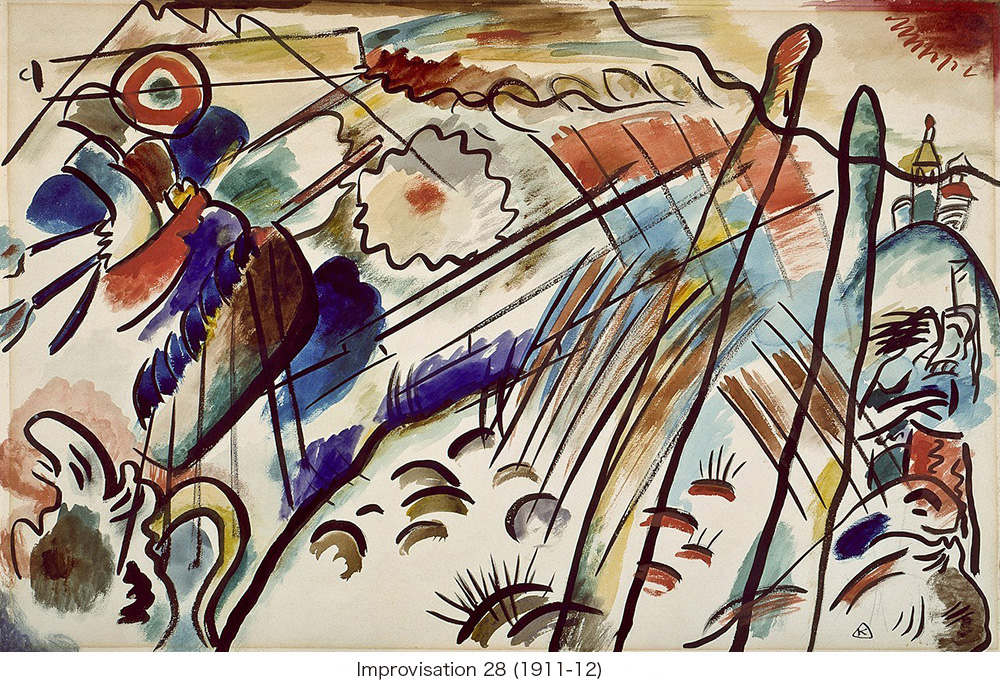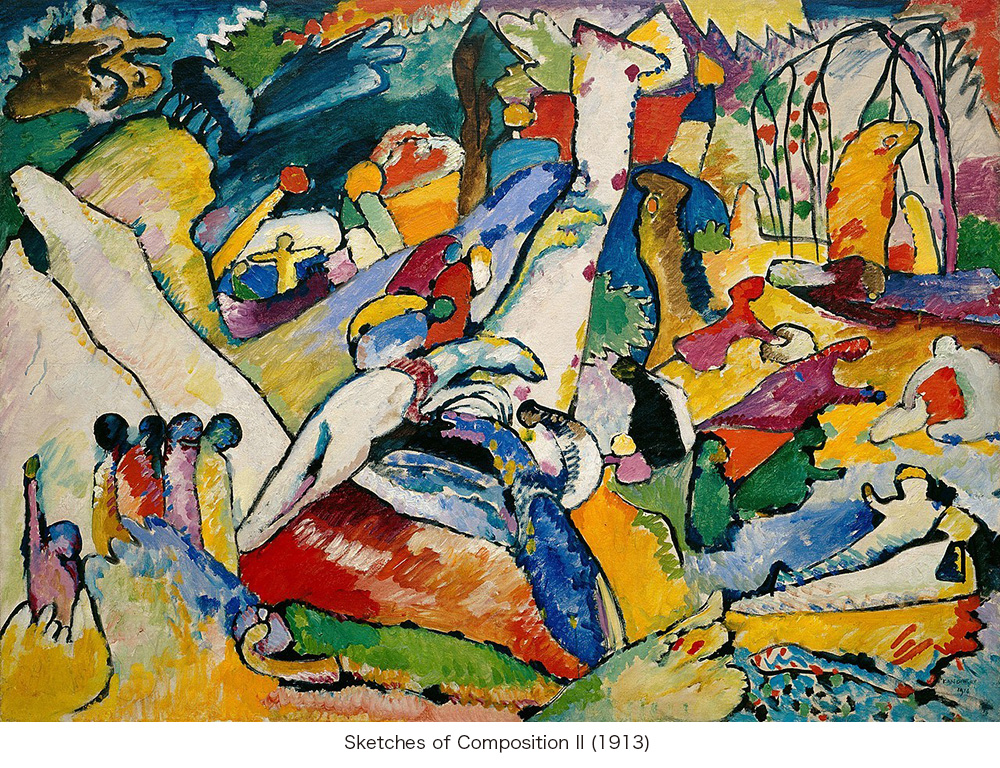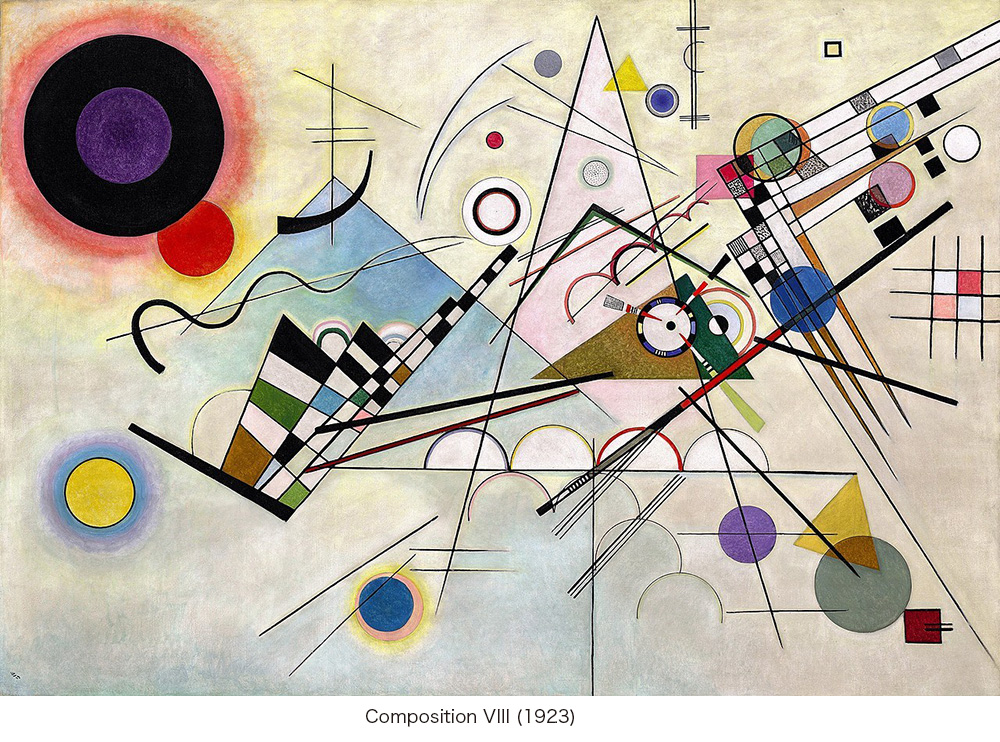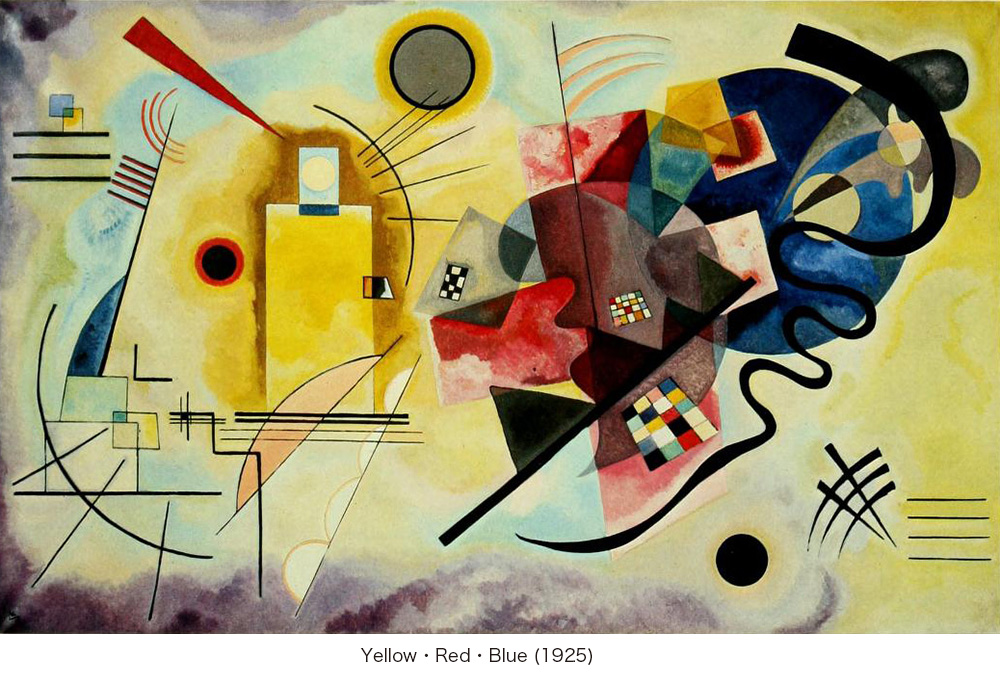The first abstract painting in the history of western fine arts was a watercolor painting by Kandinsky in 1910 (it is said to have been painted in 1913 in current research). The painting consisted of randomly scrawled lines and color patches on a 50×65cm screen, and so we don't know what it depicts or what it represents. It is one that 'it cannot be said the picture', if we say from common sense of the painting till then.
In Japan after the defeat, Nankoku's first calligraphic work was "Shin-Sen Dai-ichi 'Den-no-Variation' (Variation on Den [Lightning])" (exhibited in the 'Gendai Bijutsukyokai-ten' (Modern Fine Art Association Exhibition) in 1946), and there the bird-like shapes flying around in the air were written with thick ink lines, and from the conventional common sense of calligraphic history of writing Kanji (Chinese characters) it was "not a calligraphy".
Kandinsky was called the founder of abstract paintings in the western art history, and Nankoku created the first abstract calligraphy (avant-garde calligraphy) that he did not write characters first time. Why are they called "abstract" artists, even though the times, circumstances, and works themselves are so different? Is there merely "metaphorical name" on the surface, or is there the potential similarity that they have something common?
1. The Road to Abstraction
(1) Color of Kandinsky
Wassily Kandinsky (1866-1944) was born in Russia and was a professor of Roman law at a Russian university until the age of 30, but in 1896 he abandoned his teaching job and moved to Munich to study paintings that he had been interested in from his childhood. Until then he painted scenes of Moscow in his hometown, medieval mystic stories, and Biblical subjects by his unique colors.
Soon he moved to Munich, he had a strange experience. Kandinsky, who returned home in the evening, was fascinated by a painting on the wall. In the evening light, a beautiful picture was shining from its inside. When approaching it, he could only see the shape and the color, and he could not understand what was painted. After a short time, it was understood that the picture was his own picture hung on the wall in the opposite state of the vertical and horizontal. When he understood that it was a picture which drew "the object", the first sense did not revive well even if he laid it down on the wall. He caught his eye on "the object" even if it lay down. At that time, Kandinsky clearly noticed that "the object" was spoiling his picture.
The impressionist school denied that there was an inherent color in the object and noticed that the color of "the object" changed bathed in light. Kandinsky also realized that the color parted from the restriction of “the object" and the color had an independent world.
(2) Kandinsky's Non-figurative (Abstract) Painting
In 1911, Kandinsky formed the German Expressionist 'Der Blaue Reiter' with Franz Marc. In the days of 'der Blaue Reiter' (the Blue Knight) (1911-14), his style developed into the impression → improvisation → composition. It changed from concrete objects (landscape) to the "non-figurative" that did not draw a visible object. Even if it is said that it is non-figurative, the motives of apocalyptic visions and relief themes such as cannons, naval battles, deluge, and catastrophes in the world can be seen on the screen.
In the chaotic and ruined world of World War I and the Russian Revolution, he expressed not the concrete shapes of the dismantled external world, but the spiritual behind the material world in color and form. He expressed not the outside world, but the inner "movement of mind" of the self. His style was transformed from the "impression" of the external nature to the "improvisation" that unconsciously and instantaneously he expressed "the movement of mind", and then the "composition" that he composed over time rationally and consciously. Usually, the shape of the object is represented by an outline and colors that paint over inside the line, but Kandinsky composed paintings based on the meanings (symbolism, inner spirituality) of the lines themselves and the colors themselves, not the outline. For instance, he says, "Blue is color in the heaven, it is centripetal as the same time that it moves away from the person who sees it", and "Yellow is color on the ground, it is centrifugal as the same time that it approaches the person who sees it."
The awareness that the color and the form (line) do not depend on the object, but have purely each originality of itself is common with music. The music does not serve to represent the objects or to express feelings, based on tonality and harmony, but the sound itself is purely independent existence, and the arrangement of the sound brings an inner sound to the listener. In Kandinsky’s 'Über das Geistige in der Kunst' (Concerning the spiritual in art, published in 1912) he says, "Painting consists of the artist's inner necessity (the principle of moving the mind in purposiveness rather than by unconscious accident) and the composition of colors, forms, and the entire screen, and the picture itself brings an inner sound."
First Kandinsky's "abstraction" avoids drawing the form of concrete objects in the external world. It eliminates concrete forms to evoke the spiritual and transcendental, behind the material surface world. And it is the method of expression which composes (extracts) the non-figurative world using symbolic colors and forms (lines) to clarify the craving for the transcendental being latent in the inside of the human mind.


(3) Bauhaus "Point and Line to Plane"
In 1919, the architect Walter Gropius established a new and innovative Bauhaus by merging art and craft schools. As a professor, Kandinsky was invited to the Bauhaus in 1922 (Paul Klee had been invited the previous year) and lectured on painting theory. Kandinsky's second book, "Punkt und Linie zu Fläche" (Point and Line to Plane) summarized the lecture. The basic elements of the painting are points, lines, and planes, and the composition of these elements constitutes the painting. The accumulation only of the points is also one composition. The movement of a point produces a line, and the line represents direction and tension. A line produces a plane form such as a circle or a triangle. The movement of the "mind" which moves the point produces the line which conceives the direction and the tension, and a certain internal tension or an internal sound are born from the composition of the plane by the movement of the line.
Kandinsky's paintings of the Bauhaus period (1922-1933) transferred from emotional and irregular non-figurative (abstract) forms of the Munich period to distinct geometric forms. Geometric straight lines and curved lines weave a tense diagonal composition of the entire screen, in which circles, ellipses, parallel lines, etc. are arranged rhythmically and in an orderly manner. It is called the transition from "hot abstraction" to "cold abstraction". It can be said that theoretical and technical research in basic molding education in the Bauhaus was put into practice. However, the color and the form which had appeared in the apocalypse vision before are preserved in the screen which seems to be constructivism at first glance, and the sound of an inner spirituality is produced.
The Bauhaus was closed due to Hitler's Nazi rise in 1933, and Kandinsky was exiled to Paris.


At Nankoku’s studio in Yokohama, Bauhaus Bücher's vol.9, W. Kandinsky 'Punkt und Linie zu Fläche' (1926) (Point and Line to Plane by the Bauhaus Series Kandinsky) is left.
There is also a 1924 edition of the Idea Shoin, translated by Kuniyoshi Ohara on The Art of Kandinsky (translated by 'Concerning the spiritual in art', published in 1912). However, Nankoku learned Kandinsky's name after the creation of "Shin-Sen Dai-ichi 'Den-no-Variation' (Lightning-variation)" (presented in the 'Modern Fine Art Association Exhibition' in 1946) after the defeat.